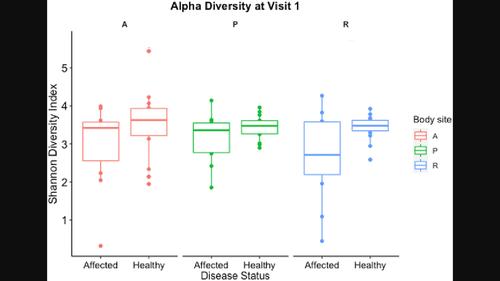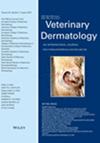对接受环孢素和酮康唑治疗的患有肛周瘘的德国牧羊犬的皮肤和直肠微生物群进行纵向评估
IF 1.9
3区 农林科学
Q3 DERMATOLOGY
引用次数: 0
摘要
背景肛瘘是一种疼痛性溃疡或窦道,对德国牧羊犬的影响尤为严重,被认为是瘘管化克罗恩病的自发动物模型。目的描述患有肛周瘘的德国牧羊犬直肠和皮肤微生物群的特征,并研究免疫调节疗法期间病变消退的纵向变化。动物11只患有肛周瘘的德国牧羊犬和15只健康的德国牧羊犬。材料和方法在接受环孢素和酮康唑治疗期间,对患病犬进行了三次评估和拭抹,每次间隔30天。同时对健康的德国牧羊犬进行采样。取样部位包括直肠、肛周皮肤和腋窝。结果在三个身体部位,健康狗和患病狗的α多样性没有显著差异(p > 0.5),但在第 0 天,患病狗的直肠和肛周β多样性与健康狗有显著差异(p = 0.004)。随着时间的推移,患犬直肠和肛周的普雷沃特氏菌属相对丰度增加,肛周葡萄球菌属相对丰度降低,这与病变的消退相吻合。结论和临床意义德国牧羊犬肛周瘘患者病变皮肤和直肠微生物群发生变化,并随着免疫调节疗法期间病变消退的时间推移而变化。我们需要进一步研究皮肤和肠道微生物群在肛周瘘发病机制中的作用,以及对微生物群的控制是否能改善疾病。本文章由计算机程序翻译,如有差异,请以英文原文为准。

Longitudinal evaluation of the cutaneous and rectal microbiota of German shepherd dogs with perianal fistulas undergoing therapy with ciclosporin and ketoconazole
BackgroundPerianal fistulas are painful ulcers or sinus tracts that disproportionately affect German shepherd dogs and are proposed as a spontaneous animal model of fistulising Crohn's disease.ObjectivesTo characterise the rectal and cutaneous microbiota in German shepherd dogs with perianal fistulas and to investigate longitudinal shifts with lesion resolution during immunomodulatory therapy.AnimalsEleven German shepherd dogs with perianal fistulas and 15 healthy German shepherd dogs.Materials and MethodsAffected dogs were evaluated and swabbed at three visits, 30 days apart, while undergoing treatment with ciclosporin and ketoconazole. Healthy German shepherd dogs were contemporaneously sampled. Sites included the rectum, perianal skin and axilla. The microbiome was evaluated following sequencing of the V4 hypervariable region of the 16S ribosomal RNA (rRNA) gene.ResultsAlpha diversity was not significantly different between healthy and affected dogs at each of the three body sites (p > 0.5), yet rectal and perianal beta diversities from affected dogs differed significantly from those of healthy dogs at Day 0 (p = 0.004). Rectal and perianal relative abundance of Prevotella spp. increased and perianal Staphylococcus spp. relative abundance decreased in affected dogs over time, coincident with lesion resolution.Conclusions and Clinical RelevanceChanges in lesional cutaneous and rectal microbiota occur in German shepherd dogs with perianal fistulas and shift over time with lesion resolution during immunomodulatory therapy. Further investigations of the role of cutaneous and enteric microbiota in the pathogenesis of perianal fistulas, and whether manipulation of microbial populations may ameliorate disease, are needed.
求助全文
通过发布文献求助,成功后即可免费获取论文全文。
去求助
来源期刊

Veterinary dermatology
农林科学-兽医学
CiteScore
3.20
自引率
21.40%
发文量
92
审稿时长
12-24 weeks
期刊介绍:
Veterinary Dermatology is a bi-monthly, peer-reviewed, international journal which publishes papers on all aspects of the skin of mammals, birds, reptiles, amphibians and fish. Scientific research papers, clinical case reports and reviews covering the following aspects of dermatology will be considered for publication:
-Skin structure (anatomy, histology, ultrastructure)
-Skin function (physiology, biochemistry, pharmacology, immunology, genetics)
-Skin microbiology and parasitology
-Dermatopathology
-Pathogenesis, diagnosis and treatment of skin diseases
-New disease entities
 求助内容:
求助内容: 应助结果提醒方式:
应助结果提醒方式:


